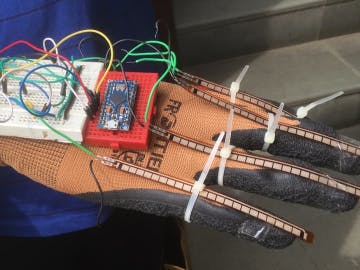RATIONALE The intention behind proposing this project is to help the hearing and speech impaired children learn and communicate normally by means of sign-language. The device proposed in this project could convert hand gestures to electrical signals which can be sent to a micro-controller that converts the signals into alphabets or commands. This would be a great blessing for these physically challenged children by reducing the communicaAon gap between their community and the normal world. It is a low cost, compact, flexible system and takes minimal power to operate.
1. To encourage the implementaAon of this project as a tool for the teaching-learning process.
2. To apply the concept of SOLE (Self Organised Learning Environment), in the teaching methodology.
SOCIAL IMPACT OBJECTIVES1. To use the end product as a teaching and communicaAon tool for the physically challenged children, by using sign language. We are considering glove-based gesture recognition as it is simple and user-friendly.
2. To develop a sense of empathy amongst students towards physically challenged children. It felt good to spread the essence of encouragement and motivation amongst the team members. But here’s something that always gives me a pause, the mere importance that giving back to the community, plays in our lives. More importantly, learning how to give back to the community.
METHODOLOGY
To execute this project, we thought of going through the design thinking process for this mission. This involved:
1. Brain storming
2. Idea and Research
3.Designing of the prototype
4.Construction and programming (Arduino)of the prototype
5. Evaluating and testing the prototype
- It was important to create cost-effective product.
The glove’s objective is to detect different hand gestures and process them to output the leeers of the American Sign Language (ASL).
- The proposed system consists of primarily two sections: 1. Transmiber Section 2. Receiver Section • The devices contained in the transmieer section are: 1. Flex sensors 2. Accelerometer Sensor 3. Arduino Pro-Micro Microcontroller 4. HC-05 Bluetooth Module.The gloves contain flex sensors which are the main sensors for this product. They are devices which can show variable resistance based on various bend angles.
- The sensors are connected in a voltage divider circuit such that the resulAng voltage is sent to one analog port of the micro-controller. The glove is mounted with 5 flex sensors, each on one finger of the glove.
FLEXSENSORCIRCUITCONNECTIONS The American Sign Language also contains letters which involve wrist movements while trying to communicate. Hence, an accelerometer sensor also supports the micro-controller to sense the gestures. The micro-controller will map these analog current signals and accelerometer values to codes corresponding to each gesture.
The device contained in the receiver section is a laptop. However, the glove can communicate with any bluetooth receiver to perform appropriate actions. The codes that are mapped by the micro-controller are processed by the receiver so that the laptop can show the detected text on the screen. It can also convert the speech to text which can be played by a speaker.
OUTCOME AND EDUCATION IMPLICATIONS PEDAGOGICAL OUTCOME This project provides an effective method of engaging students and helping them to develop important 21st century skills such as creative, problem solving, critical thinking and presentation skills. The concept of SOLE actually prepares them to develop problem solving skills with effecAve teamwork with a backbone of motivation.
SOCIAL OUTCOME This project, if implemented would be useful for the hearing and speech impaired children by providing them a medium through which they can communicate with one another and with normal children. The standard sign language used by the speech impaired children is hard to interpret for a common man. This device could convert the sign language into voice thereby making the process simpler. The output is also displayed on a screen for hearing impaired children as well. The uneducated hearing and speech impaired children of the society can be taught simple alphabets, leeers, words that can be used for day to day communication..
THE FUTURE OF “THE SMART HAND GLOVE”FUTURE ENHANCEMENTS
1. The glove is modeled based on a particular hand. Since hands differ in size and freedom of motion, we can improve the glove to work with every hand size by giving it adaptive learning capabilities.
2. In the current project, the output is displayed using a Personal Computer. To improvise the portability, an Android application can be developed for displaying the text and speech output on an Android device. Alternatively, the algorithm can be implemented on a Raspberry Pi for portability.
3. If and when the product is produced in a large scale, the entire circuit can be embedded into a single chip.
4. This prototype can also be modified for the benefit of visual impaired children by adding ultrasonic sensors. Smart gloves are poised to be a big part of the future of computing, so our prototype has the potenAal to have a much broader impact in the marketplace even if they started the project with a much more humanitarian motive. For some, the notion of using your hands to speak may seem odd, but considering how olen we communicate through emails, chats, tweets, blogs, and articles without using our voice, those of us who can communicate orally are in a better position than ever to celebrate the smart hand glove’s efforts alongside those who look forward to technology himng the shelves.
MONEY MATTERS! The approximate cost of each glove that we created is about Rs.6000/-, but we forecast that this will drop by almost 50% once we refine the development and produce the device in mass quantities.The product could be replicated and used by other schools and institutes for educating and developing communication skills amongst the hearing and speech impaired children.
REFERENCESThis mission could not have been possible without the resources from various sources all over the internet such as:
1. https://learn.sparkfun.com/tutorials/flex-sensor-hookup-guide
2.http://www.kscst.iisc.ernet.in/spp/39_series/SPP39S/02_ExhibiAon_Projects/146_39S_BE_1831.pdf
3.http://people.ece.cornell.edu/land/courses/ece4760/FinalProjects/f2014/rdv28_mjl256/webpage/
4. https://www.nidcd.nih.gov/health/american-sign-language
5. www.arduino.cc




_PnKPri8a6q.jpg?auto=compress%2Cformat&w=48&h=48&fit=fill&bg=ffffff)












_3u05Tpwasz.png?auto=compress%2Cformat&w=40&h=40&fit=fillmax&bg=fff&dpr=2)
Comments
Please log in or sign up to comment.